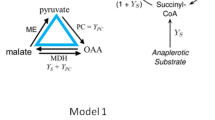Summary
For those systems which are amenable to tracer kinetic incorporation experiments it is possible to determine the pathways of nutrient flux throughout the system and to measure the steady state rates of intercomponent mass transfer through these pathways. In this paper a procedure is developed which allows one to employ incubation experiments to obtain the data required to analyse the flow of nutrients throughout the system. In such experiments a tracer is introduced via a single system component and the total radioactivities of the other system components are measured and recorded as functions of the time elapsed since the introduction of tracer. The resulting time-varying radioactivity curves can be successfully fitted to sums of exponentials by employing a particular mode of data point weighting. A specific mode of weighting the data points is required in typical incubation experiments if the component injected with label is large in comparison with the remaining components of the system. The exponential sums describing the time-varying radioactivities of the system components furnish the information required to determine and measure intercompartment nutrient fluxes; such determinations are made by assembling the coefficients and exponents appearing in the sums, into matrices, then employing a collineatory transformation. An illustrative example of the determination of intercomponent rates of mass transfer from data arising from a simulated incubation experiment is presented.
Similar content being viewed by others
References
Berman, M., Schoenfeld, R.: Invariants in experimental data on linear kinetics and the formulation of models. J. appl. Physics 27, 1361–1370 (1956)
Bevington, P. R.: Data reduction and error analysis for the physical sciences. New York: McGraw-Hill 1969
Confer, J. L.: Interrelationships among plankton, attached algae, and the phosphorus cycle in artificial open systems. Ecol. Monogr. 42, 1–23 (1972)
Conover, R. J., Francis, V.: The use of radioactive isotopes to measure the transfer of materials in aquatic food chains. Mar. Biol. 18, 272–283 (1973)
Corner, E. D. S., Davies, A. G.: Plankton as a factor in the nitrogen and phosphorus cycles in the sea. In: Advances in marine biology, F. S. Russel, M. Yonge, Eds., p. 101–204. London: Academic Press 1971
Eppley, R. W.: An incubation method for estimating the carbon content of phytoplankton in natural samples. Limnol. Oceanogr. 13, 574–582 (1968)
Hohn, F. E.: Elementary matrix algebra, 2nd ed., 395 pp. New York: Macmillan 1965
Hutchinson, G. E., Bowen, V. T.: Limnological studies in Connecticut. IX. A quantitative radiochemical study of the phosphorus cycle in Linsley pond. Ecology 31, 194–203 (1950)
Lasker, R.: Feeding, growth, respiration, and carbon utilization of a euphausiid crustacean. J. Fish. Res. Bd Can. 23, 1291–1317 (1966)
Malone, T. C.: The relative importance of nannoplankton and netplankton as primary producers in tropical oceanic and neritic phytoplankton communities. Limnol. Oceanogr. 16, 633–639 (1971)
Perl, W.: A method for curve-fitting by exponential functions. Int. J. appl. Radiat. Isotopes 8, 211–222 (1960)
Sheppard, C. W.: Basic principles of the tracer method. New York: Wiley 1962
Smith, D. F., Holmes, R. A.: Kinetics of allosteric inhibition in vivo: a quantitative analysis with synchronous cultures of Blastocladiella emersonii. J. Bact. 104, 1223–1229 (1970)
Thomas, J. P.: Release of dissolved organic matter from natural populations of marine phytoplankton. Mar. Biol. 11, 311–323 (1971)
Wade, T. L.: The algebra of vectors and matrices. Cambridge: Addison-Wesley 1951
Watt, W. D., Hayes, F. S.: Tracer study of the phosphorus cycle in sea water. Limnol. Oceanogr. 8, 276–285 (1963)
Author information
Authors and Affiliations
Rights and permissions
About this article
Cite this article
Smith, D.F. Quantitative analysis of the functional relationships existing between ecosystem components. Oecologia 16, 97–106 (1974). https://doi.org/10.1007/BF00345575
Received:
Issue Date:
DOI: https://doi.org/10.1007/BF00345575




